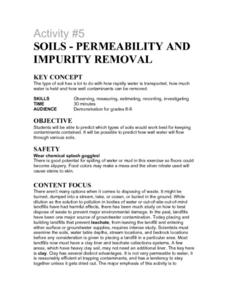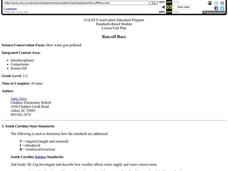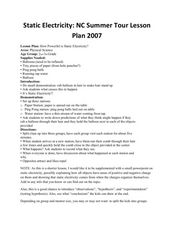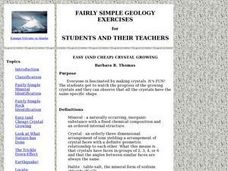Curated OER
Who Took Jerell's iPod? ~ An Organic Compound Mystery
Within the setting of a crime scene investigation, biochemistry beginners analyze organic compounds as a means of determining "Who dunnit." They use a brown paper test for lipids, glucose test strips and iodine to identify carbohydrates,...
University of Georgia
Energy Content of Foods
Why do athletes load up on carbohydrates the evening before a competition? The lesson helps answer this question as it relates the type of food to the amount of energy it contains. After a discussion, scholars perform an experiment...
Consortium for Ocean Science Exploration and Engagement (COSEE)
Carbon Dioxide & Krill: Impacts
What effects do temperature and carbon dioxide levels have on the zooplankton of Antarctica? This concluding lesson plan in a short unit on climate change and the ocean helps environmental scientists answer these questions. After...
Texas State Energy Conservation Office
Nuts! Calculating Thermal Efficiency
Oh nuts! Do macadamias or almonds produce more thermal energy? Energy enthusiasts find out with this experiment. The objective is to demonstrate to your class how the chemical energy contained in foods can be converted into useable...
American Chemical Society
Comparing the Amount of Acid in Different Solutions
Upcoming chemists use chemical reactions to determine relative pH in two different acids. This is a terrific lesson for middle schoolers that can stand alone as a practice in precision and lab skills, or as part of the unit on chemical...
Curated OER
Dissolving Salt
Fifth graders, in groups, complete an experiment/activity in which they dissolve salt in a cup of hot water and then observe what happens as the water evaporates over the next few weeks.
Curated OER
Activity #5 Soils-Permeability and Impurity Removal
Middle schoolers predict which types of soils would work best for keeping contaminants contained. They comprehend that in the past, landfills have been one major source of groundwater contamination. Pupils comprehend that placing and...
Curated OER
Time, Tide, and Quahogs
Students read tide tables for Waquoit Bay as the simulate determining the best time to go clam digging for a Wampanoag clambake. They graph the tide tables while realizing that the tides a Waquoit Bay are one hour later than those at...
Curated OER
Oily Oceans
Students, after reading Jack, the Seal and the Sea, by Gerald Aschenbrenner, get a hands-on knowledge of the effects of oil on water, and those things that come in contact with it.
Curated OER
Run-off Race
Pupils create wetland models in pans and use them to experiment to see how plants help slow the flow of runoff water and keep our waterways clean.
Curated OER
Solubility Lab
In this solubility worksheet, students test a variety of polar and non polar substances to determine which ones will dissolve in vegetable oil and which ones will dissolve in water. Students collect data and answer 2 questions about...
Curated OER
Problem-Solving Strategy: Use Logical Reasoning
In this logical reasoning worksheet, 4th graders read a paragraph about what three students are brought for lunch before determining what each student eats through logical reasoning. They record what they understand, make a plan, fill in...
Curated OER
Locating the Salt Front - Section 1
In this salt front of the Hudson River worksheet, 7th graders first read an excerpt about the lower portion of the Hudson River that is an estuary. Then they use a colored pencil to plot salinity data from the table shown on a graph,...
Curated OER
Observing Osmosis
Students investigate osmosis using egg cells with the shells removed. In this osmosis lesson plan, students remove the shell of an egg by letting it soak in vinegar for two days. They take measurements and observe the cell. They soak the...
Curated OER
Fizzy Pop
Fifth graders compare and identify variables that affect the rate of a chemical change using Alka-Seltzer, water, ice, and hot water. They time how long each variable takes to pop the canister into the air, and record the results on a...
Curated OER
Composition of the Atom
Learners investigate the structure of the atom and its composition. In this atom structure lesson, students find the area of cut out circles and drop pens into the circles. They count the number of marks in the circles and relate their...
Curated OER
Dolphins
Students explore sea life. In this cross curriculum fine arts, science, and P.E. "dolphins" activity, students sing songs and play games about dolphins, perform water experiments, create mosaics, and use their five senses to explore sand...
Curated OER
Erosion: Natural or Unnatural
Students explore how water has the power to erode, how developing the land (building roads, buildings and parking lots) increases the amount of water reaching our rivers, and how this greater quantity of water increases erosion. They...
Curated OER
How Powerful is Static Electricity?
Students break up into groups to complete a demonstration rubbing a balloon in hair make their hair stand up. Thus, they conclude static electricity. They also experiment with a paper station, ping pong station and a water station...
Curated OER
Periodic Properties Lab
Young scholars investigate the periodic properties of elements in the periodic table. In this periodic properties lesson plan, students experiment with elements from the Alkaline Earth Metals, the Halogens, the Transition Metals, and for...
Curated OER
What Makes a Habitable Planet?
Students list conditions necessary for humans to survive. They then mix yeast with a nutrient broth consisting of warm water and table sugar in a plastic bottle, capping it with a party balloon and compare the factors within the bottle...
Curated OER
Dynamic Earth
Students show how earthquakes affect sea waves. In this tidal waves instructional activity students use a rubber mallet on a table to create waves in a box on top of the table. They experiment with striking the mallet in different...
Curated OER
Function of a Stem
Fourth graders perform an experiment to test the function of a stem. In this science lesson, 4th graders write a description of their investigations. Students also explain how the stem interacts with the rest of the plant. Students use...
Curated OER
EASY (AND CHEAP) CRYSTAL GROWING
Students grow salt crystals by making a saturated solution of table salt and let the solution sit around and evaporate.
Other popular searches
- Aquifer Water Table
- Water Table Diagram
- Water Table and Recycling
- Water Table Erosion Sand
- Sand and Water Tables
- Making a Water Table
- Science Water Table
- Soil and Water Table
- Water Table Activities
- Location of Water Table
- The Water Table























